Tech Talk - The Potential for Future Production from Romania
Posted by Heading Out on January 23, 2012 - 2:57pm
There are violent protests taking place in Bucharest, Romania, which carry with them the threat of destabilizing the government, as we have seen in countries which lie further south. But while countries involved in the “Arab Spring” have oil and natural gas that are being exported, Romania is no longer a leader in production and export of petroleum products, and now imports them. Yet back in 1837, it was reportedly the first country to have an oil industry, reaching a production of 1719 barrels a year. It was also, in 1900, the first country to export gasoline, at a time when it was producing some 5,000 barrels a day. That made it the then third largest producer in the world. But by the 1930’s the country had fallen to seventh place, even though Romania was still the second largest producer in Europe, behind the Soviet Union.
By the time of the Second World War, the oil fields of Ploetsi were underpinning the operations of the German military machines, providing an estimated third of that country’s need. Attempts to bomb the fields were prolonged and, though they were not always successful and the fields and refineries continued to provide fuel for most of the war, the continued bombing finally got production down to 7% of capacity.

UPDATE: I have added Jean Laherrere's more recent prediction below the fold.
Following the war, the region fell into the Soviet zone of influence. Production picked up and rose until 1980, following which, it has declined until fairly recently.
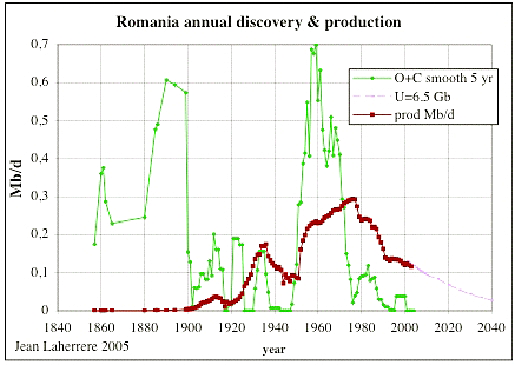
UPDATE: Jean Laherrere has been kind enough to update this figure with a more recent plot, as follows, and I thank him for the kindness.
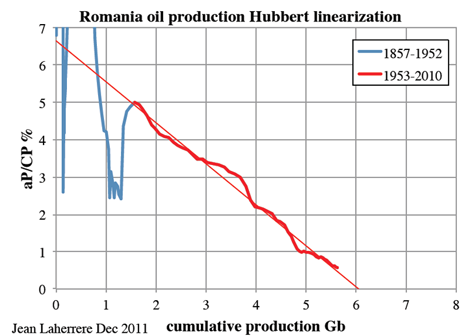
More recently, as demand has continued to rise, the country has had to rely increasingly on imports.
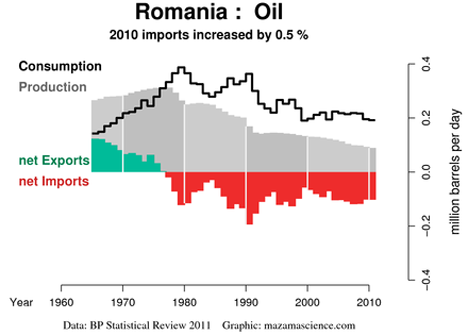
Similarly, peak natural gas production was also around 1980, with the country barely keeping a declining supply in tune with falling demand since then.
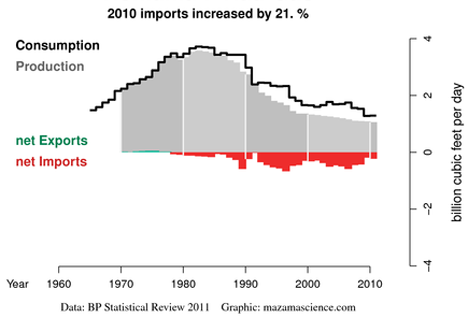
(The country started nuclear production in the late '90s and has significant coal production.)
The nine oil fields in the Ticleni region, one of the older oil producers in the country, has just changed management hoping thereby to increase production of 4,500 bd from some 300 wells to over 6,000 bd.
Seismic exploration, introduced after WW II, helped make the majority of the discoveries that led to peak oil production in 1976. It has been the use of 3-D seismic that revealed much of the potential not developed in the past.
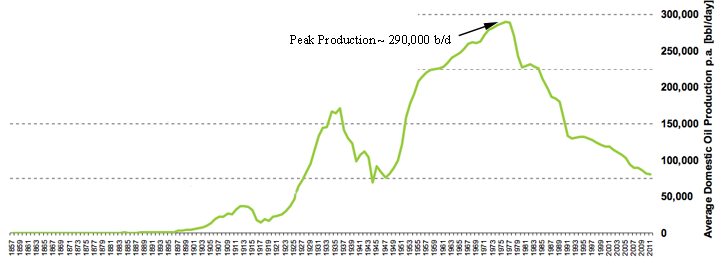
Petrom was privatized in 2004, and began paying a dividend in 2010. Exploration offshore began in 1975, with oil production starting in 1987 from the Lebada East Field. By the end of 2010, total production from a total of 250 fields had risen to 174 kbd.
Encouraged by recent activity, Melrose has begun investing money in the offshore Black Sea. This follows a recent trend in which the Deepwater Champion entered the Black Sea to drill off Turkey, last March. Just this month it has moved off the Romanian coast, after having terminated work at two sites off Turkey. Drilling is under an ExxonMobil/Petrom partnership, with Exxon Mobil providing the funds. If the initial well proves out, plans are to invest more than $3 billion in developing the prospect.
The historic fields have all been onshore around Torcesti for oil and Mamu for natural gas, while the new fields offshore are in deeper water, such as the Delta. It is currently anticipated that crude oil reserves are around 420 million barrels, with some 2 Tcf of natural gas, though there is potential for more.

There is still an ongoing effort to redevelop mature oilfields in the country; steam injection will be tried this year using long horizontal holes, rather than the vertical used to date, in the heavy oil SUPLAC field in the west of the country. Water injection is to be tried in the OPRISENESTI field in the East, and polymer injection is being considered for the VIDELE field in the South. VIDELE was earlier the site for a successful World Bank funded project that used in-situ combustion to try and reverse the declining production of this and the BALARIA fields. The treatment was intended to increase ultimate oil recovery from 15% to 39% of the OIIP. In 1998, Supalcu de Barcau was the largest in-situ combustion project in the world, with about 9,000 bd of production.
More recently, the discovery of a new reservoir in the TOTEA gas field, and a new well currently on test, has the potential to be the largest gas find on shore in six years.
However, much of the future looks deep offshore in the potential of fields such as the NEPTUN. (Though the company is hedging its bets by also building a wind farm).
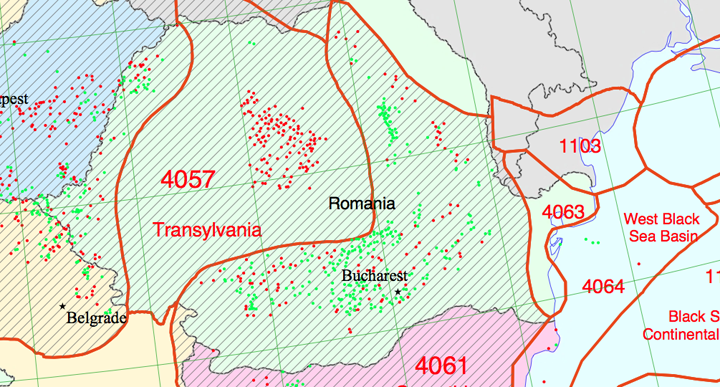
The new exploration and development is shared between Petrom and Romgaz, who have 55% of the natural gas sites in the country.
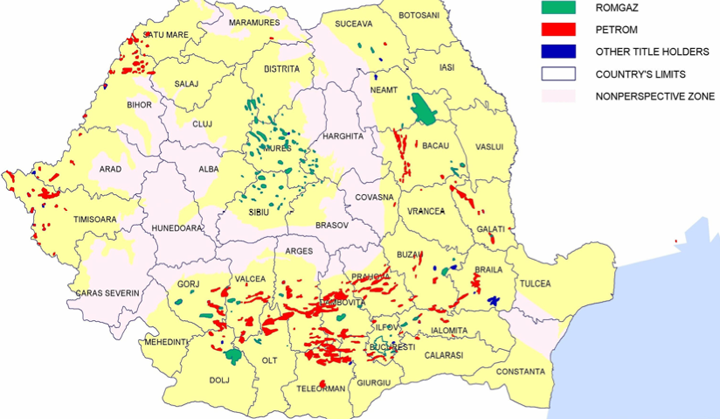
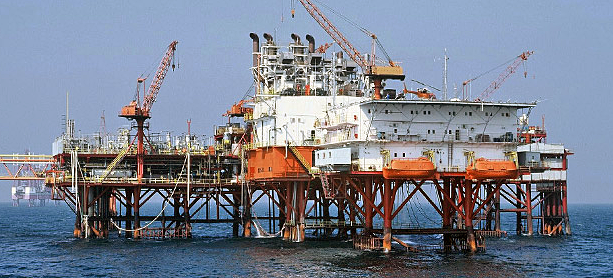
While the current production from the Delta IV field is on the Continental Shelf, the new exploration is ranging into the deeper waters of the NEPTUN field, where the Deepwater Champion program is scheduled to last some 90 days. Water depth fluctuates from 160 ft to 5,500 ft over the field, but the first hole has been spudded in 3,200 ft of water. The field is a hundred miles offshore, and has undergone the largest 3-D seismic survey in Romanian history prior to the drilling program.
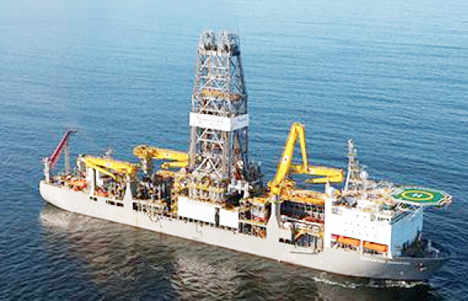
The maritime dispute with Ukraine was settled in 2009, setting up the bidding offshore, and estimates for the Neptun field run up to 3 Tcf of natural gas and 73 million barrels of oil. Unfortunately, even if these discoveries pan out they are unlikely to have much impact on the problems in Bucharest, although perhaps by the time that oil is brought ashore, they will be over and production might be sufficient to help with the country's budgets. But that thought includes a lot of possibly wishful thinking . . . and that future will not be here for several years yet, even if it should come to pass.




It's sad that we've gotten to the point that we are actually talking about such a small producer. It's interesting how their discovery peak is so close in years to their production peak...
MrEnergyCzar
It is more sad, that The Oildrum has stopped analyzing the production of the World and the great producers.
Please do world oil forecasts again!
When it comes to world oil production, the whole is precisely equal to the sum of it's parts.
Heading Out is going to great pains to carefully examine the current and potential future production of each producing nation. This approach is the only meaningful way to go about determining current and potential future world oil production.
World oil forecasts without this kind of careful analysis are only hand-waving guesstimates.
Jon
Old regions are interesting, they could provide a lot of information on what could be expected from newer regions.
I might disagree by mentioning that using production rates to predict future production is not only fraught with danger but sometimes is completely ludicrous. Anyone remember the oil peak of the USSR predicted by the CIA? Like in the 80's? Global peak predicted by Colin Campbell in 1989? Saudi Arabia is another perfect example, standing in 1985, predicting their production rates in 2010 from production you might be inclined to think they were going to run out soon, rather than what happened instead.
World oil forecasts without an appropriate geologic context, discovery process model and accounting for more-stabilized-than-expected production rates because of flattening decline rates due to the expanding use of a particular technology are only hand-waving guesstimates.
Throw in predicting the production potential based on capital expenditures and geopolitical issues with Canada and Venezuela, and maybe even most of what I've previously said is also a guesstimate, considering the potential of these two countries alone.
In 1989 the world population was 5.204 billion people. Today it's 7 billion -- and still growing. Maybe the world should have listened to Colin Campbell in 1989.
Maybe the world did. But global oil production sure ignored him.
I think the real question is whether your view is unique to yourself or is emblematic of the Oil Industry in general. If it is indicative of a general attitude in the Oil Industry, I don't know what to say.
I don't consider the lack of peak oil in 1989 to be a "view". More like a fact. I doubt the oil industry worried about his claim very much, if I recall his bio correctly, by then he was doing some consulting and wasn't working for an oil company, consultants are notorious for finding ways to get their name out to try and drum up some work.
I can only speak on behalf of myself: it is offensive the way this PO/doomer community disses the education, experience, intelligence and hard work of oil and gas professionals.
Give a group of geologists, geophysicists and engineers money and time and they will find a way to find oil.
"Give a group of geologists, geophysicists and engineers money and time and they will find a way to find oil."
To state the obvious, it's not just a matter of finding Oil. It's a matter of extracting it economically.
That's what engineers are best at.
Of course the problem is an incremental increase in production, in selected areas, versus making a material difference.
Sam Foucher looked at North Sea oil fields whose first full year of production was 1999 or later. These new fields had a peak of about one mbpd in 2005, as the new fields served to slow the overall North Sea post-1999 decline rate to about 5%/year.
Globally the cumulative efforts of the entire global oil industry have not been able to keep global crude oil production on an upward slope.
North Sea production in 1996 lined up with Global crude oil production in 2005 (different rates of increase leading to the production plateaus, but the two plateaus, so far, are quite similar):
If previously disproven statements of running out and early peak oil claims are any indication, they do it well.
I think that these Tech Talks are informative and help build my understanding of the World oil picture from the bottom up. HO, Thank you for your past and continuing efforts.
Here here! The monthly oil analysis reports are much missed. It would be nice to see some breakdowns between crude oil, unconventional, and biofuels as well. That data is not readily apparent in EIA and IEA reports. Further, it would be good to have some analysis external of those and industry sources.
I actually live in Romania and I see the prices on gasoline going up every month.
It is indeed a small country but I can tell you the obsession with cars iin Romania is so big that you won't believe. In Bucharest the people fight over parking lots every day. There are areas inside the city where the sidewalks are used entirely as parking lots and the pedestrians are forced to walk on the roads! I love to walk at night when the city is quiet and I can tell you there is no parking lot available anywhere. Now the cars are parked directly in the middle of crossroads where it is more space after the sunset and the drivers are trying to wake up early to remove the cars before they are removed by police. Yes, Romania is a small producer but many people here ar so much in love with the cars (not just cars, SUVs are very popular) that thay can give up a meal just to save the money for gasoline. Romania is an European country but the people here always desired and tried to copy the american way of life startig from early '60s. In short, no matter what they will do on production side... the consumption is going up
Thanks so much for contributing a Romanian perspective on consumption. The American "love affair with the car" is not restricted to America.
I do have one nuance to add to your comment: According to the JODI database, gasoline consumption has been steady over the past nine years. It is actually diesel that shows a steady increase in consumption. From the prototype JODI databrowser:
The chart above shows that Romanian consumption of gasoline is fairly flat and that refineries produce enough for a modest export. This is in contrast with refinery production of diesel:
According to the JODI data, Romanian refineries are having a tough time keeping up with increasing demand for diesel resulting in increasing imports.
A more thorough analysis might look at the revenues/expense for exporting/importing these different products and how that plays into Romania's economic situation.
Regards,
Jon
Gasoline consumption remains flat because most of old cars that are coming off the road have gasoline engines and an increased percentage of new cars have diesel engine. Also the overall efficiency of the fleet has increased a lot due to rapidly increasing gasoline prices and EU standards that are active since Romania join EU in 2007. Most of the gasoline price increase in due to taxes that are now at EU levels.
Diesel consumption will continue to grow and in my opinion there are 3 main factors:
1. increased percentage of new cars have diesel engine
2. increased consumption in the agriculture sector . EU subsidies and increased foreign investment in this sector combined little mechanization and lots of unused land will make for a steady increase of diesel consumption in the next 5-10 years
3. increased transport of goods by truck. Because of change in the economic structure freight is now smaller and more diverse making tucks better suited for this. Practically no investment in rail system in the last 20 year contributes to migration of freight from rail to trucks. Since 2007 some investment was made in rail system but this takes time and for now there is no significant change. Average speed on rail is still lower than in 1990.
In regard with the import of diesel some of that can by accounted by the difference in diesel EU standards. Most of the refinery capacity was modernized to meet EU standards as Romania joined EU in 2007 and probably able to produce euro 5 ultra-low-sulfur diesel . Euro 5 was mandatory from September 2010 when data shows an increase in import at that time. From import comes lower quality diesel that can still be used in tractors and trucks and export euro 5 diesel. I'm not very sure about this so it can be the other way around (Romania imports for lack of euro 5 capacity) .
Romania is a net exporter of refined products and has a big interest to remain so even if oil production continues to drop. This is because residual fuels can provide energy security from Russian natural gas imports.
Cogeneration power plants located near big cites that account for much of heating in winter are now usually run on 30% residual fuels(maybe less) and 70% natural gas. Before 2007 when the 2nd nuclear reactor became operational they run on residual fuels and were used all year round for base load. Now they can be switch to 100% residual fuels in 24-48h as it happened in 2008–2009 winter when natural gas imports to Europe stopped due to Russia–Ukraine gas disputes.Supply now is kept at ~90 day enough for a winter with no natural gas imports.
Thanks, Jon
Dave
I'm a romanian too , it's true that a part of the population has a real obsession with cars but only a small part are financially capable to fulfill it :) . Just see the graphs - the consumption is almost flat for the last 10 years , and this was a booming period for car sales . Also I think the old petrochemical industry beeing dismantled had a important effect in negating the consumption of the new cars , together with the fact that those cars were in a big proportion replacements for our rusting dacia fleet which although a small car was about 20-30% more fuel thirsty that a average modern vehicle of similar type.
The fuel prices going up are a combination of higher taxes (acciza) , higher VAT , our currency devaluation and some greedines from the local oil companies wich were fined a considerable sum recently (but for another reason - the coordonated elimination of the cheapest kind of gas).
Personally i don't see the consumption up , not a bit , not at least in the present economic times and we know what future brings ... Also i don't expect future street movements this year , not with local and general ellections just months away . Those were a tentative from one political party -which is one part of the oposition - to capitalise on a major gaffe made by the president and the normal population discontent.
I haven't read the article yet. One note though - please replace everywhere Ploetsi with Ploiesti (see http://en.wikipedia.org/wiki/Ploiesti).
It is fun to see a map with Yugoslavia on it. Brings back memories.
So many "new" names now:
http://0.tqn.com/d/goeasteurope/1/0/Z/L/-/-/EasternEuropeMap.jpg
The well-documented rise and fall of a source of oil, one of pivotal strategic historical importance, is educational: a great demonstration of oil's reality.
Even funnier is the map of Italy, where it seems that Bologna and a large part of Po valley have been flooded by the sea...
Note that the projected cumulative production for Romania, a critically important producing region in the Second World War, is 6 Gb. Currently, on a global basis, we are consuming the equivalent of more than four Romanias per year.
Notice also that Romania peaked around 1935...declined for better than a decade...and then began increasing production and created a new peak some 40 years later. Does anyone have a model which would have predicted the second peak in 1975 based on a vantage point from 1940 or so?
Looks like the Thirties peak was around 1938. I'm just guessing here, but perhaps the subsequent decline had something to do with events in Europe from 1939 to 1945?
wt - You mean like maybe someone dropping bombs on those fields? I'm sure even you west Texas wussies wouldn't let a thang like that slow you up. LOL. Odd how old memories can jump out of no where. The first serious book that I actually remember reading was "Low Level Mission" about the air raids on Ploesti. Can't recall how old I was but reading wasn't one of my better skills: still couldn't recite the alphabet completely by my first year of high school. I'm going to try to find that book and see if I can understand why stuck with me all these years. Oddly when grandma saw the title she thought it had something to do with the Catholic church.
Heck...found it that fast. Amazon truly is amazing. And a used paperback is only $1.
From a review: "Still the book has its virtues, and it needs to be read by anyone studying the attack. The prose is wonderfully vigorous. The introduction by Colonel John R. "Killer" Kane addresses some of the controversies, and it is a moving tribute to those who flew the mission. The maintenance preps for the mission are very well told. Wolff's evaluation of the mission's effect is even-handed and hard-headed. There are chapters on the subsequent 1944 high altitute attacks on the same target".
So we've got the first peak in Romania because of WWI, the second peak because of WWII, and the most recent peak because of soviet style development, with the article referencing more modern techniques now being applied. I wonder why Jean doesn't reference the overall recovery factor for the entire country, a number which just jumps out at anyone who compares that extrapolation to the OOIP numbers for the fields in the country.
Also, there is a reference in the article to 175K a day because of these newer development techniques, but it doesn't show up on the production graph for the entire country? Did those fields mentioned spike to 175K for a day or two, or was that really a sustained rate?
According to German historian Dietrich Eichholtz, the peak was in 1936:
Eichholz then presents a table of the ten largest companies, their stock value, yearly production (1938) and nationality of controlling interest. I'll just post the table notes to the three largest:
Eichholz goes on to state that german financial interests at that point only controlled three tiny oil companies in Romania.
It appears to me that the three years of decline from '36 through '39 was involuntary -- that it was "business as usual" for the western-controlled companies until the German invasion of France, Belgium and the Netherlands in '40, when German interests (Deutsche Bank seems to have been the most important one) aggressively sought possession of the French/British/Belgian/Dutch companies operating in Romania, by a mixture of means. Much of the French holdings seem to have been handed over as part of the ceasefire agreement. Others seem to have been bought up under duress or downright confiscated. British personell seems to have fled Romania by this time, but the Dutch were seemingly largely re(de?)tained after German pressure on the Romanian govt.
So sabotage or voluntary production curtailment on behalf of the companies based in countries hostile to Germany seems to have taken place, but also looks like a minor factor.
Eichholz has this explanation for the continued production drop-off:
Actual acts of war didn't have an impact until 1944.
Interesting. An exhaustion of productive fields? Sounds familiar. It is more than a little surprising how common claims of exhaustion, decline and running out are in the past, only to be discarded by the harsh reality of the resource pyramid and capital investment. Well, maybe Romania won't have another peak, but it certainly has enough oil remaining in the ground to put a wooden stake through that 6 GB ultimate estimate.
So, based on the source you quoted, you are saying that the war years' production decline had "something to do with events in Europe from 1939 to 1945?"
In any case, to return to my observation about Romania--a critically important producing region in the Second World War, in the context of our current global consumption levels--apparently the peak production rate was 290,000 bpd for Romania, and they reliably supplied 200,000 bpd or more for several years.
ExxonMobil estimated that existing oil wells worldwide are declining at 4% to 6% per year. Let's use 5%, or about 3.7 mbpd per year (C+C).
So, just to offset the ongoing decline from existing wells worldwide, we need something like 13 to 19 Romanias found, and fully developed every single year* (depending on whether one uses the Seventies peak rate or a lower more sustained production rate).
*Or 130 to 190 over a 10 year period.
As Deffeyes predicted, so far new conventional and unconventional production worldwide has not been sufficient to keep global crude oil production on an upward slope. To maintain the 2002 to 2005 rate of increase in global crude oil production and to offset the underlying decline rate from existing wells, we would have needed 21 to 31 new Romanias found and fully developed every single year from 2005 to 2010:
We have seen a material, but quite small, rate of increase in total liquids production, an annual rate of increase of 0.5%/year from 2005 to 2010, inclusive of low net energy biofuels and NGL's, EIA.
Meanwhile, our data base shows that the global supply of (net) exported oil (total petroleum liquids) available to importers other than China & India (ANE) fell at an average volumetric rate of one mbpd per year from 2005 to 2010. I am estimating that the average volumetric ANE decline rate will accelerate to between 1.4 mbpd and 2.0 mbpd per year from 2010 to 2020.
And, as Deffeyes has predicted, now that we are more than 5 years past his peak oil date, we are over the hump as it were, and well on to the better world he envisioned for the planet as it adjusts to our new post peak world. You have to give him credit, no one else first predicted both global peak oil correctly, and then supposed that 5 years later we would all be in pretty good shape, and then this all happened.The guy deserves kudos for his prognostication.
A site that celebrates 150 years of oil in Romania.
http://www.150deanidepetrol.ro/history.html